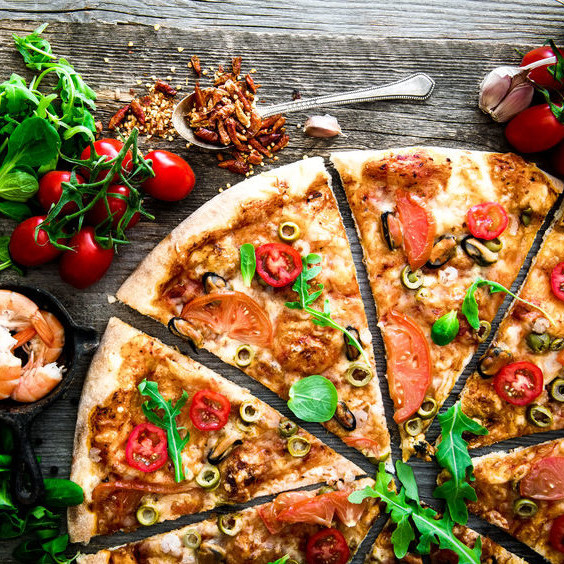
Pizza
What is Pizza?
Pizza is a one of the most widely consumed savory bakery products in the world. It is a type of flatbread commonly topped with tomato sauce and cheese. Today, it’s become an extremely convenient food product, with sales of over $37 billion annually just in the US alone.1
Types differ based on toppings or crust volume:2
- Traditional crust: is not too thin or thick, with a solid structure.
- Deep dish: also known as pan pizza, with a thick and dense crust.
- New York style: characterized by its extremely thin crust.
- Calzone: folded pizza filled with classic toppings.
- Sweet: classic pizza crust topped with chocolate spread, fruits or nuts.
Origin
A type of flatbread similar to pizza is thought to have been produced by the Phoenicians, Romans or Greeks.1
Today’s version may have originated in Italy in 1889. During a visit of King Umberto and Queen Margherita di Savoia, a neapolitan baker named Raffaele Esposito produced a pizza with tomato sauce, mozzarella cheese and basil to simulate the colors of the italian flag. Italians brought it to the US in the beginning of the 20th century, and in 1905 the first American pizza place opened in New York City.1
Nutrition
Typical nutritional value per 100 g serving is:3
| Component | Grams |
| Water | 47.8 |
| Carbohydrate | 30.5 |
| Lipid | 11.5 |
| Protein | 10.2 |
Pizza is high in fat and carbohydrates. It provides 265 kcal per 100 g and is considered highly caloric.3
Commercial production
Pizza can be industrially produced through the following process:4
- Kneading: flour and water are mixed together in a removable stainless steel bowl. Other ingredients like sugar, starch and yeast are added manually.
- Lamination: the dough is laminated with several rollers to reduce its thickness. The obtained sheet is introduced to the cutting machine to produce different shape bases.
- Topping: the toppings like tomato sauce, cheese and others are automatically added to the bases.
- Baking: the pizzas are placed on a conveyor belt and passed through the baking oven at 150-232 °C (300-450 °F).
- Packaging: pizzas are flow-packed and sealed in an automatic packaging machine.
Common ingredients
Pizza’s essential ingredients are:2
| Ingredient | Usage level | Characteristic |
| Flour | ~59% | Fresh: <12% protein content.
Frozen:11-14% protein content. It has to be elastic and extensible. |
| Water | ~36% | Excessive water: sticky dough
Inadequate: bucky dough, difficult to stretch. |
| Yeast | 1-2% fresh
3-4% frozen |
Mixing should be done at 24 °C (75 °F). |
| Salt | 1.5-2% | |
| Sugar | Fresh: 3-6%
Frozen: 8-10% |
Provides food for the yeast and water retention. |
| Shortening | 0.7-1% | Required for improvements of frozen dough. |
| Ascorbic acid | 70-100 ppm depends on flour weight. | Improve structure and volume. |
| Cheese | As required | Typically mozzarella cheese is used.
Other cheeses can be used that have elasticity and stringy body. |
| Tomato sauce | Another core ingredient of basic pizza. |
Processing conditions
Optimum cooking temperature for a roman pizza in a wood fired oven is between 325-330 °C (617-626 °F) for 2 min. However, these temperatures can’t be accomplished in household ovens. So, the highest safe temperature setting should be used.
Frozen or refrigerated pizza typically undergoes a cryogenic process with liquid nitrogen or mechanical refrigeration with an air blast. Another alternative may be the use of modified atmosphere packaging.
Regulations
Pizza is not specifically regulated by the FDA. However, the regulation status of its core ingredients wheat flour, cheese, and tomato sauce are established as GRAS.
In the EU, pizza is also not regulated as a direct item. However, its core ingredients are regulated by the EU Commission.The EU Commission 97/2010 exists for the register of traditional Napoletana Pizza.5
References
- Edwards, W. P. The science of bakery products. Royal Society of chemistry, 2007.
- Singh, P., Goyal, G.K. Functionality of pizza ingredients. British Food Journal 113.11 (2011):1322-38.
- U.S. Department of Agriculture, Agricultural Research Service. FoodData Central, 19 January 2018. https://fdc.nal.usda.gov/fdc-app.html#/food-details/414420/nutrients . Accessed 22 September 2020.
- Liberopoulos, G, and Tsarouhas, P. “Reliability analysis of an automated pizza production line.” Journal of Food Engineering 69.1 (2005): 79-96.
- European Commission (EC). Commission Regulation NO97/2010 entering a name in the register of traditional specialities guaranteed [Pizza Napoletana (TSG)] . Official Journal of European Communities, 04 February 2010.

